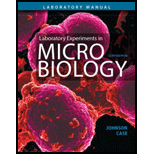
To analyze:
The reason for development of system for the identification of Enterobacteriaceae.
Introduction:
Enterobacteriaceae is a large family that belongs to basically gram-negative bacteria. The members of this family are generally Enterobacter, Klebsiella, Salmonella, Shigella, E.coli, Proteus, and Serratia. These bacteria are found in human gut, skin, soil, sand, and diary products.
Explanation of Solution
Bacteria are generally divided into two categories, gram-negative and gram-positive bacteria. The gram-negative bacteria are further divided into enterics and non-fermenters. From a long time, various substrates were being used to differentiate between non-fermenters and enterics. Both these groups are responsible for the cause of various bacterial infections in the human population. Therefore, it was important to develop a system that would help in identifying the members of Enterobacteriaceae.
The reason for development of system for the identification of Enterobacteriaceae is tp handle the diseases in humans caused by them.
Want to see more full solutions like this?
Chapter 51 Solutions
Laboratory Experiments in Microbiology (12th Edition) (What's New in Microbiology)
- 19) Which of the following BEST describes an agent that is bactericidal? A) Windex. B) It suspends bacterial growth. C) It kills the bacteria. D) It causes the bacteria to destroy themselvesarrow_forwardIf you discover new bacteria from the sands of Culebra's beaches that have the ability to degrade plastids, how would you identify these bacteria? Explain the methods you would use before reporting your discovery. What tests would you do to prove that they are not from the Enterobacteriaceae family? Discuss in at least 3 paragraphs.arrow_forwardWhat are the common pathogens isolated from stool samples? What is the difference between a coliform bacterium and a noncoliform enteric bacterium? What diagnostic test differentiates Proteus and Providencia species from other Enterobacteriaceae? How would you differentiate between serotypes of E. coli? Are the gram-negative enteric bacilli fastidious organisms? Would they survive well outside of the body? If so, what significance would this have in their transmission? Why is serotyping particularly important in Salmonella infections and typhoid fever?arrow_forward
- How was the product of streptomycin isolated by the scientist who discovered this?arrow_forwardWhat does Bergey's Manual of Determinative Bacteriology mention about the Genus Escherichia?arrow_forwardHow do the methyl-red and Voges-Proskauer tests differentiate between certain members of the Enterobacteriaceae?arrow_forward
- 21) The use of Penicillin and Bacteriocins are examples of: a) Toxin-mediated killing b) Viral mediated lysis c) Predation-mediated killing d) Metabolite inhibitors e) DNA inhibitors 22) Evaluating the effectiveness of a chemical or reagent is done through: a) Periodic transfer and refrigeration b) the Phenol Coefficient test c) Lyophilization d) Viral mediated lysis e) a and b23) Salmonella typhi and Staphylococcus aureus are two species used in: a) Toxin-mediated killing b) Viral mediated lysis c) Predation-mediated killing d) Autoclave effectiveness evaluation e) Phenol Coefficient test24) Chemotherapeutics have ____ Toxicity: a) Broad spectrum b) General c) Differential d) Selective e) c & d 25) The gas that has been used recently used to decontaminate biological safety cabinets is: a) EtO b) Beta-propiolactone c) NO Gas d) N2O Gas e) Vapor-phase H2O2arrow_forwardWhich of the following is a consideration in treating bacterial infections A) Bacteriostatic b) bactericidal c) broad spectrumarrow_forwardIf a experiment took place with culture of Ecoli What happens to the ampicillin flask when added to the e coli? b) How can this effect be explained 11.a) What happens in the flask with chloramphenicol? b) How can this effect be explained 12.a) What happens in the flask with streptomycin? b) How can this effect be explainedarrow_forward
 Human Anatomy & Physiology (11th Edition)BiologyISBN:9780134580999Author:Elaine N. Marieb, Katja N. HoehnPublisher:PEARSON
Human Anatomy & Physiology (11th Edition)BiologyISBN:9780134580999Author:Elaine N. Marieb, Katja N. HoehnPublisher:PEARSON Biology 2eBiologyISBN:9781947172517Author:Matthew Douglas, Jung Choi, Mary Ann ClarkPublisher:OpenStax
Biology 2eBiologyISBN:9781947172517Author:Matthew Douglas, Jung Choi, Mary Ann ClarkPublisher:OpenStax Anatomy & PhysiologyBiologyISBN:9781259398629Author:McKinley, Michael P., O'loughlin, Valerie Dean, Bidle, Theresa StouterPublisher:Mcgraw Hill Education,
Anatomy & PhysiologyBiologyISBN:9781259398629Author:McKinley, Michael P., O'loughlin, Valerie Dean, Bidle, Theresa StouterPublisher:Mcgraw Hill Education, Molecular Biology of the Cell (Sixth Edition)BiologyISBN:9780815344322Author:Bruce Alberts, Alexander D. Johnson, Julian Lewis, David Morgan, Martin Raff, Keith Roberts, Peter WalterPublisher:W. W. Norton & Company
Molecular Biology of the Cell (Sixth Edition)BiologyISBN:9780815344322Author:Bruce Alberts, Alexander D. Johnson, Julian Lewis, David Morgan, Martin Raff, Keith Roberts, Peter WalterPublisher:W. W. Norton & Company Laboratory Manual For Human Anatomy & PhysiologyBiologyISBN:9781260159363Author:Martin, Terry R., Prentice-craver, CynthiaPublisher:McGraw-Hill Publishing Co.
Laboratory Manual For Human Anatomy & PhysiologyBiologyISBN:9781260159363Author:Martin, Terry R., Prentice-craver, CynthiaPublisher:McGraw-Hill Publishing Co. Inquiry Into Life (16th Edition)BiologyISBN:9781260231700Author:Sylvia S. Mader, Michael WindelspechtPublisher:McGraw Hill Education
Inquiry Into Life (16th Edition)BiologyISBN:9781260231700Author:Sylvia S. Mader, Michael WindelspechtPublisher:McGraw Hill Education





